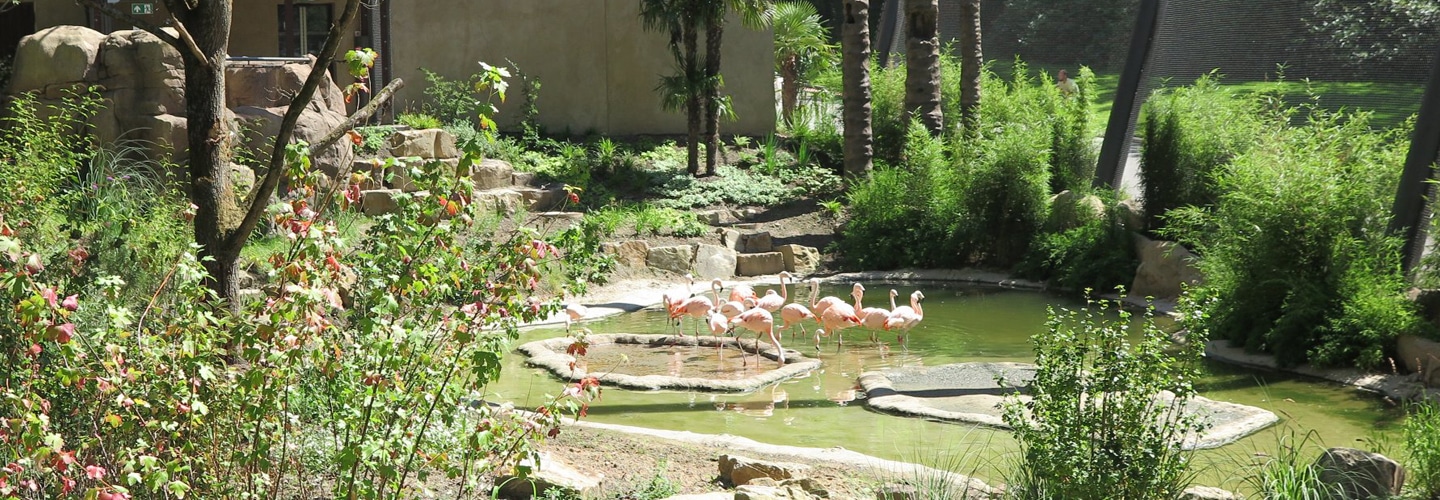Uplifted! In front of the red-brown clay wall, cobalt-blue hyacinth macaws flap their wings and noisily snap at food. The spectacular activity of this rare and critically endangered parrot species can be observed in Aralandia.

With ARALANDIA, one of the largest macaw aviaries in Europe has been created. What makes it special: the aviary is walk-in, allowing visitors to experience the animals up close in a truly immersive way. But it’s not just the colorful macaws that can be encountered at eye level—thanks to a mixed-species concept, parakeets, flamingos, and pudus can also be observed in close proximity. The architecture team around Kieran Stanley, CEO dan pearlman experience architecture, was responsible for developing a design plan and supervises the implementation until the final opening. The client of the ARALANDIA project ist Zooverein Wuppertal e.V.
Endangered Parrot Species
Cobalt blue-feathered hyacinth and indigo macaws flutter and snatch noisily at mineral-rich feed. In the future, the rare, endangered parrot species and its spectacular movements can be observed in an unparalleled way at Wuppertal Zoo. The extrodinary fact: the aviary is open for visitors what offers a one-of-a-kind experience with the animals. But it’s not only macaws that visitors can meet on eye-level. Based on the mixed-species approach of the concept, people can also experience conures and pudus at close quarters.
Gateway to the Green Zoo Wuppertal
The new free-flight aviary at the Green Zoo Wuppertal will welcome guests right at the entrance of the zoo, setting the tone for an engaging and inspiring visit. As part of the long-term vision “The Green Zoo Wuppertal 2020”, the macaw aviary aims to make education tangible and to communicate information through compelling storytelling. In doing so, it raises public awareness for species conservation and highlights the zoo’s ongoing commitment to nature protection. Parrots, as flagship species for conservation in Brazil, also represent the collaboration with the Loro Parque Foundation and related joint projects.
An immersive journey through the aviary
To immerse themselves in the world of the birds, visitors receive their first insights into the life of parrots even before entering the aviary. The path begins through an existing kiosk made of natural-toned textured concrete, seamlessly transitioning to the natural ground of the aviary interior. From there, visitors pass through an entry lock into a semi-dry savanna landscape. The trail leads along a stream and a rising red-brown clay and rock wall. Countless macaws perched on the wall offer a vibrant palette of red, blue, yellow, and green—both a visual and acoustic spectacle, and a unique photo opportunity. The path continues past a small waterfall and through a cave that provides fascinating views into the exhibit and animal care building. A raised wooden deck offers new perspectives and a quiet resting spot above the landscape. The trail then descends past an idyllic pond with turtles before reaching the Ara Discovery Gallery, where guests can explore species conservation and the zoo’s projects in an engaging, hands-on way. Further views into the adjacent flamingo aviary complete the experience.
Insights into breeding and pairing behavior
A dedicated breeding aviary for endangered macaws is also planned as part of the Ara Breeding Center. Here, visitors can observe how suitable pairs are selected for these monogamous birds.
Architectural concept with flowing structures
The architectural concept offers emotional and authentic insights into the animals’ lives. The aviary is designed to provide both sweeping views and intimate glimpses within a cohesive landscape setting. The overall design is intentionally understated. Organically curved steel arches span the aviary, evoking the wingbeats of flying birds while following the spatial needs of the environment below. These support-free arches, up to 30 meters long, blend harmoniously into the overall landscape and give the structure a distinctive, contemporary character. A fine black mesh stretched across the arches ensures transparency, allowing the surrounding landscape to visually flow through the structure—creating a nature-inspired experience for visitors inside the aviary itself.
Pictures: Barbara Scheer, Peter Frese